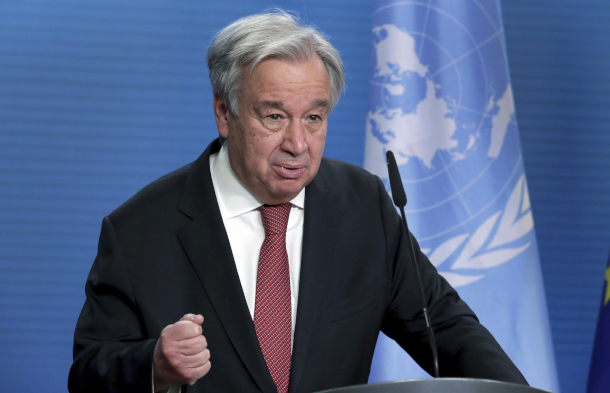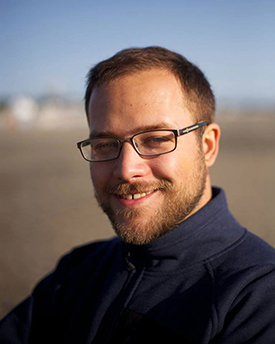UN Report Charts Possible Climate Futures
Air Date: Week of August 20, 2021

Working Group I of the Intergovernmental Panel on Climate Change has released their portion of the 6th Assessment Report, which focuses on the physical science aspect of global warming. (Photo: Ania Mendrek, Flickr, CC BY-NC-ND 2.0)
Scientists are once again sounding the alarm about the climate emergency, with part one of the 6th Assessment Report from the Intergovernmental Panel on Climate Change, or IPCC. Hundreds of experts collaborated to bring together the best science on past, present, and future climate change. Zeke Hausfather is a climate scientist and contributor to the most recent IPCC report, and he joins Host Jenni Doering to unpack the UN climate report.
Transcript
BELTRAN: From PRX and the Jennifer and Ted Stanley Studios at the University of Massachusetts Boston, this is Living on Earth. I’m Paloma Beltran.
DOERING: And I’m Jenni Doering.
Scientists are once again sounding the alarm about the climate emergency, with part one of the 6th Assessment Report from the Intergovernmental Panel on Climate Change, or IPCC. Hundreds of experts collaborated to bring together the best science on past, present, and future climate change. Dr. Zeke Hausfather is a climate scientist and contributor to the most recent IPCC report, and he joins us now. Welcome back to Living on Earth, Zeke!
HAUSFATHER: Thanks. It's great to be here.
DOERING: So I know that there are a whopping 4000 pages in this report. But I wanted to start by zooming way out. What are the most important takeaways from this IPCC report?
HAUSFATHER: So the most important takeaway at the top level is that, you know, there's an immense amount of scientific consensus at this point on some basic points about climate change: that it's real, it's caused by us, it'll be bad if we don't do anything about it. But we still have the power to decide how much warming the world experiences. But beyond that, it is a summation of the state of climate science. And there's a lot of new things that are reflected in this report that have changed over the last decade, you know, we have more certainty on the human role in warming. The report makes it very clear that our best estimate of the human contribution to the warming the world has experienced is pretty much all of it. About 100% of the warming the world has experienced is due to human activities according to the new report. It also unclouds our climate crystal ball in a really important way. So there's a concept in climate science called climate sensitivity. And what climate sensitivity refers to is essentially how much warming you get if you increase the amount of greenhouse gases in the atmosphere. And the reason that's a little bit uncertain is because there's a lot of feedbacks in the earth system. You know, if you increase the amount of CO2 in the atmosphere, you get more evaporation, you get more water vapor in the air, water vapor itself is a greenhouse gas and it traps more heat. You know, you get ice melting, revealing darker surfaces that absorb more sunlight. And so all these different types of feedbacks play together to determine how much warming the world experiences. And for a long time, there's been a range that climate scientists have given essentially, saying, if you double the amount of co2 in the atmosphere, you'll get somewhere between 1.5C, and 4.5C global average warming. That was the range given in 1979, in the Charney Report to the Carter administration, that was also the same range given in 2013 in the last major IPCC report. So you know, 30 years, and that range has remained fiendishly large, but what this IPCC report does for the first time is meaningfully narrow that range, and they say, you know, now we think if you double the amount of CO2 in the atmosphere, you end up with somewhere between 2.5 and 4 degrees warming globally. So that's half the uncertainty that we previously had in this range. And that's a really important advancement. And so narrowing this range is both bad in terms of less likely to have low amounts of warming and good in that some of the worst case scenarios now seem a little less likely.
DOERING: So Zeke, you're actually one of the reports, many contributing authors, what specific area did you work on?
HAUSFATHER: So, my research is cited in a number of areas of the report, the place I directly worked on in the report was on evaluating the performance of old climate models. So we looked at all of the climate models that have been published between 1970 and the early 2000s. And we look to see, you know, what did those models say would likely happen in the years after they were published, essentially, how much warming did they project, and then how much warming actually occurred in the real world. And it turned out that a lot of these climate models did a really good job at predicting what actually happened. We looked at 17 different climate model projections. Of those, 11 were indistinguishable from the rate of warming that happened in the real world. And the ones that missed off, about half of them were a little too low, and half of them were a little too high. And you know, this is really impressive, especially for the early models, you know, the first models published in the early 1970s. At the time, scientists didn't have a really good sense of what was happening to the world's temperatures, they hadn't gone around the world and digitized all these old logbooks and weather station records. And were relying mostly on a small number of temperature measurements from the northern hemisphere. And so in the early 70s, a lot of scientists thought that the world was actually slightly cooling at the time and had been for the last decade or two. And so essentially, what they were saying is, you know, we think this cooling trend is going to reverse, and the world is going to warm by 0.6 degrees centigrade by the year 2000. And that turns out is exactly what happened. You know, granted, the world wasn't actually cooling at the time as they thought, you know, we have better data now. And you know, the temperatures were mostly flat and starting to rise in the early 70s. But the fact that they predicted the amount of warming, you know, spot on is really impressive, and a testament to the fact that, you know, our climate models are getting the fundamentals right.

United Nations Secretary-General António Guterres described the 6th Assessment Report from the IPCC as “a code red for humanity”. (Photo: Faces of the World, Flickr, CC BY 2.0)
DOERING: To what extent do you think we've really grasped this different world that we're now seeing?
HAUSFATHER: I think, in some ways, what's happened over the last few years has made it much clearer for people than it used to be. You know, we used to talk about climate change as a problem for our children and our grandchildren. But with increasing heat waves, with increasing floods, which are due to higher amounts of water vapor in the atmosphere due to warming, massive wildfires ravaging the West Coast and you know, smoke covering the entire country at times now, the last few years have brought climate change home in a way that makes people realize that this is not a problem for our children and grandchildren. This is a problem that's affecting us today. And it's affecting us already. And you know, that's at 1.2 degrees Centigrade warming. And so it helps people see you know, just how much worse it can get if if we don't take action to cut our emissions.
DOERING: Right. I mean, I think UN Secretary General Antonio Guterres really called this IPCC report a "code red" for humanity. Could you break down for us how within reach is a lower emissions path at this point? And how does it compare with what people like to call "business as usual"?
HAUSFATHER: So that's a great question. You know, a decade ago, the world was in a really bad place as far as our climate goes, you know, global emissions had increased by 30% in just the past decade. And it seemed like we were heading toward a future where coal dominated the 21st century, and we might double or even triple our emissions in the next 80 years. Thankfully, things have started to change over the last decade, global coal use peaked at back in 2013, you know, clean energy has has largely become cheap, you know, prices of solar panels have fallen by a factor of 10 in the last 10 years, battery prices have fallen by a factor of 10, wind prices have fallen by a factor of three. And so we've started sort of flattening the curve of future emissions. You know, it seems like now we're entering a long plateau of emissions under policies that are in place today. But that still would lead us to, you know, somewhere around three degrees warming by the end of the century, under current policies. And as I mentioned, there are these uncertainties in climate sensitivity and carbon cycle feedbacks. So we certainly can't rule out four degrees warming or even more in the current policy world, even though our best estimate is three. And a three degree world is also not one we want to live in, it would be, you know, really hard for a lot of human systems to deal with, particularly in poorer countries where they don't have access to air conditioning or cooling centers or other sort of sea walls, adaptive capacity. And it would be devastating for natural ecosystems, which can't change nearly fast enough to keep up with that amount of warming.
DOERING: Well, so, how on track are we right now for potentially a lower emission scenario that's more in line with a two degrees C warming world?
ClimateChange 2021: the Physical Science Basis - provides the most updated physical understanding of the climate system and #climatechange, combining the latest advances in climate science, and multiple lines of evidence.
— IPCC (@IPCC_CH) August 9, 2021
➡️ https://t.co/uU8bb4inBB
➡️ https://t.co/4t8uyqoLXN pic.twitter.com/bUN6fQcjWY
HAUSFATHER: So we're not on track for a below two degree warming world today. We would need to take much more action than we are right now. And that requires policy. It's not just that we're gonna have some magical technological breakthroughs that have got the whole world there without, you know, strong policy interventions by countries. But it's a lot more possible to imagine that world today, it seems a lot more likely than it did just five years ago, in part because countries are starting to make longer term commitments that are more in line with a below two degree world. In the last year, we've seen a number of countries including the US, the EU, China, Japan, South Korea, etc, commit to get their emissions to zero by the middle of the century, either 2050 or 2060. Now, you know, if the US and China and the EU and these other major emitters do succeed in getting their emissions to zero by 2050, or 2060, that is in line with keeping global temperatures well below two degrees. The challenge for us all is though, it's very easy for countries to promise to do something 30 to 40 years from now. How seriously we take those commitments really depend on how well they're reflected in near-term policies.
DOERING: Lengthy as it is, this report from Working Group I is just the first part of the sixth IPCC edition. So when can we expect the next parts of this report to come out? And what can we expect that they'll say?

Zeke Hausfather is a climate scientist and Director of Climate and Energy at the Breakthrough Institute. (Photo: Courtesy of Zeke Hausfather)
HAUSFATHER: So Working Group II, which covers the impacts of climate change on human and natural systems will be coming out early next year. And it will sort of use all of the latest science about what is likely to happen to the climate that came out in this most recent report, to look at what that means for various ecosystems, what that means for agriculture, what that means for heat waves and cities. And I think it'll, you know, paint a pretty dire picture of potential impacts, particularly in a world where we don't reduce our emissions, and give us a lot more clarity on exactly what those impacts will be. And then Working Group III is more about solutions. It'll be out next summer. And it'll explore both, you know, where the world is headed today, and what the likely pathways are that the world could take. But also, you know, what we can do to reduce our emissions, the best way we can transition the global energy system away from fossil fuels, and toward clean energy, you know, what that will cost, what the benefits of it will be. And sort of some of the equity considerations around this, you know, making sure that the countries that are responsible for the problem are the ones that are doing the most to solve it. Because one of the challenges of climate change fundamentally, is that our emissions accumulate in the atmosphere. And so what is causing climate change isn't our emissions last year, it's all of our emissions since the Industrial Revolution. And so even though countries like China and India are big emitters today, they're not responsible for the majority of what is in the atmosphere that's causing warming right now. But that also means we really need leadership and resources devoted from the rich countries to help everyone else, you know, not repeat the mistakes we made that have screwed up the climate in the process, you know, we can't slam the door behind us and tell you know, India, that sorry, our development was too damaging, so you can't develop yourselves and catch up to the luxuries that we enjoy here in the US and lift hundreds of millions of people out of poverty in the process. Right, you know, that sort of message isn't gonna work and so helping countries with technology transfer, with green financing, allowing them to, you know, minimize the amount of fossil fuels they're going to use in the future and move more quickly to clean energy without sacrificing the development needs of the people live there is going to be key. And while the rich world is responsible for half of the emissions today, and most of the historical emissions, it is going to be the poor and middle income countries that are going to be responsible for most of future emissions if we don't develop in a way that is green, and that is low carbon. And so it's really critical that we all work together on this challenge and that we create a prosperous world without destroying our planet in a way that's you know, is equal for for everyone and not just, you know, benefits the rich.
DOERING: Dr. Zeke Hausfather is a climate scientist and contributor to the most recent IPCC report. Thank you so much for taking the time with us today.
HAUSFATHER: Thanks. Great to be here.
Links
Read the 6th Assessment Report from the IPCC
The Breakthrough Institute | “Flattening the Curve of Future Emissions”
Living on Earth wants to hear from you!
Living on Earth
62 Calef Highway, Suite 212
Lee, NH 03861
Telephone: 617-287-4121
E-mail: comments@loe.org
Newsletter [Click here]
Donate to Living on Earth!
Living on Earth is an independent media program and relies entirely on contributions from listeners and institutions supporting public service. Please donate now to preserve an independent environmental voice.
NewsletterLiving on Earth offers a weekly delivery of the show's rundown to your mailbox. Sign up for our newsletter today!
 Sailors For The Sea: Be the change you want to sea.
Sailors For The Sea: Be the change you want to sea.
 The Grantham Foundation for the Protection of the Environment: Committed to protecting and improving the health of the global environment.
The Grantham Foundation for the Protection of the Environment: Committed to protecting and improving the health of the global environment.
 Contribute to Living on Earth and receive, as our gift to you, an archival print of one of Mark Seth Lender's extraordinary wildlife photographs. Follow the link to see Mark's current collection of photographs.
Contribute to Living on Earth and receive, as our gift to you, an archival print of one of Mark Seth Lender's extraordinary wildlife photographs. Follow the link to see Mark's current collection of photographs.
 Buy a signed copy of Mark Seth Lender's book Smeagull the Seagull & support Living on Earth
Buy a signed copy of Mark Seth Lender's book Smeagull the Seagull & support Living on Earth

